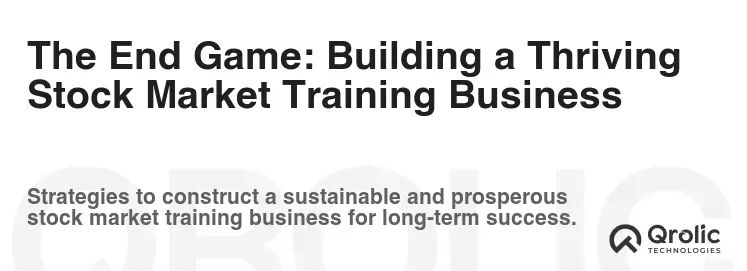Quick Summary:
- Build trust with clear design and strong value.
- Engage students using interactive learning and community.
- Drive traffic and optimize results with smart marketing.
- Continuously improve based on data and student feedback.
Table of Contents
- The Cornerstone: A High-Converting Stock Trading Website
- 1. Visually Appealing and Trustworthy Design
- 2. Crystal-Clear Value Proposition
- 3. Compelling Course Showcase
- 4. Secure and Easy Online Enrollment
- 5. Lead Generation Magnet: Free Resources and Content
- The Engine Room: Features for Engaging and Retaining Students
- 6. Interactive Learning Platform
- 7. Community Forum
- 8. Personalized Learning Paths
- 9. Live Q&A Sessions
- 10. Success Stories and Testimonials
- The Marketing Arsenal: Driving Traffic and Conversions
- 11. SEO-Optimized Content
- 12. Blog with Valuable Trading Insights
- 13. Social Media Integration
- 14. Email Marketing Automation
- 15. Retargeting Campaigns
- The Analytical Compass: Tracking and Optimizing Performance
- 16. Website Analytics (Google Analytics)
- 17. Conversion Tracking
- 18. A/B Testing
- 19. Heatmaps and User Session Recordings
- 20. Customer Feedback Surveys
- Leveraging Qrolic Technologies for Your Stock Market Training Website
- The End Game: Building a Thriving Stock Market Training Business
The Cornerstone: A High-Converting Stock Trading Website

A website is more than just a digital brochure; it’s the central hub of your stock market training business. It’s the first impression, the sales funnel, and the ultimate source of credibility. But not all websites are created equal. To truly thrive, your website needs specific features designed to attract, engage, and convert aspiring traders into paying students. This section will delve into the critical components of a high-converting stock trading website, answering the “what,” “why,” and “how” behind each feature.
1. Visually Appealing and Trustworthy Design
What: This encompasses the overall aesthetics of your website – the color palette, typography, imagery, and layout. It’s about creating a design that’s both professional and inviting.
Why: Visual appeal instantly impacts a visitor’s perception. A well-designed website conveys professionalism, competence, and trustworthiness – crucial in the financial training space. Conversely, a poorly designed website can deter potential students before they even explore your offerings. Think of it as the digital equivalent of a well-maintained office versus a cluttered, disorganized one.
How:
-
Professional Color Palette: Choose colors that evoke trust and stability. Blues and greens are commonly used in finance. Avoid overly bright or clashing colors.
-
High-Quality Imagery: Use professional photos and videos of yourself, your team (if applicable), and success stories. Avoid generic stock photos that lack authenticity.
-
Clean and Intuitive Layout: Ensure your website is easy to navigate. Information should be readily accessible and logically organized. A clear hierarchy of content is crucial.
-
Mobile Responsiveness: With the majority of online traffic coming from mobile devices, your website must be fully responsive. This means it should adapt seamlessly to different screen sizes.
-
Consistent Branding: Use your logo, colors, and typography consistently throughout your website to reinforce your brand identity.
Benefit: A visually appealing and trustworthy design builds instant credibility and encourages visitors to explore your offerings further. It lays the foundation for a positive user experience.
2. Crystal-Clear Value Proposition
What: Your value proposition is a concise statement that explains what you offer, how you solve your target audience’s problems, and what differentiates you from the competition.
Why: In the crowded stock trading education market, you need to immediately capture visitors’ attention and explain why they should choose you. A clear value proposition answers the fundamental question: “What’s in it for me?”
How:
-
Identify Your Target Audience: Who are you trying to reach? Beginners? Experienced traders looking to refine their strategies? Knowing your audience is crucial for crafting a relevant value proposition.
-
Highlight Key Benefits: Focus on the tangible benefits students will receive, such as learning specific trading strategies, gaining confidence, or achieving financial independence.
-
Differentiate Yourself: What makes you unique? Do you specialize in a particular trading style? Do you offer personalized coaching? Emphasize your unique selling points.
-
Use Strong, Action-Oriented Language: Use words that evoke emotion and convey a sense of urgency.
Example: “Learn to trade with confidence. Master proven strategies and unlock your financial potential with our step-by-step stock trading course.”
Benefit: A compelling value proposition instantly grabs attention, clarifies your offering, and motivates visitors to learn more. It sets you apart from the competition and increases conversion rates.
3. Compelling Course Showcase
What: The course showcase is the section of your website dedicated to highlighting your stock trading courses and programs.
Why: This is where you sell your expertise and convince potential students that your courses are the right investment for their trading education. A well-crafted course showcase is essential for converting website visitors into paying customers.
How:
-
High-Quality Course Descriptions: Write detailed and engaging descriptions for each course. Include the course objectives, learning outcomes, target audience, and prerequisites.
-
Curriculum Overview: Provide a comprehensive outline of the course content, including modules, lessons, and topics covered. This gives potential students a clear understanding of what they will learn.
-
Video Introductions: Create short, compelling video introductions for each course. These videos allow you to connect with potential students on a personal level and showcase your teaching style.
-
Student Testimonials: Feature testimonials from satisfied students who have benefited from your courses. Social proof is a powerful tool for building trust and credibility.
-
Pricing and Enrollment Options: Clearly display pricing information and enrollment options for each course. Make it easy for potential students to sign up.
-
Frequently Asked Questions (FAQ): Address common questions about your courses, such as the time commitment, the level of experience required, and the refund policy.
Example:
Course Title: “The Ultimate Stock Trading Masterclass”
Description: “Unlock the secrets to consistent profitability with our comprehensive stock trading masterclass. Learn proven strategies for identifying high-potential stocks, managing risk, and maximizing your returns.”
Curriculum:
- Module 1: Introduction to Stock Trading
- Module 2: Technical Analysis Fundamentals
- Module 3: Fundamental Analysis Techniques
- Module 4: Risk Management Strategies
- Module 5: Advanced Trading Strategies
Benefit: A compelling course showcase provides potential students with all the information they need to make an informed decision about enrolling in your courses. It increases conversion rates and drives revenue.
4. Secure and Easy Online Enrollment
What: This refers to the process of students registering and paying for your courses online.
Why: A seamless and secure enrollment process is crucial for maximizing conversion rates. Any friction or difficulty in the enrollment process can lead to lost sales.
How:
-
Secure Payment Gateway: Integrate a secure payment gateway such as Stripe or PayPal to protect student’s financial information.
-
Multiple Payment Options: Offer multiple payment options to accommodate different student preferences.
-
Clear and Concise Instructions: Provide clear and concise instructions for the enrollment process.
-
Mobile-Friendly Enrollment: Ensure the enrollment process is fully mobile-friendly.
-
Automated Enrollment Confirmation: Send automated enrollment confirmation emails to students upon successful registration.
Benefit: A secure and easy online enrollment process reduces friction, increases conversion rates, and provides a positive user experience.
5. Lead Generation Magnet: Free Resources and Content
What: A lead magnet is a valuable resource that you offer for free in exchange for a visitor’s contact information (usually their email address).
Why: Building an email list is essential for nurturing leads, promoting your courses, and building long-term relationships with potential students. Lead magnets are a highly effective way to generate leads.
How:
-
Identify Your Target Audience’s Pain Points: What are the biggest challenges faced by aspiring stock traders?
-
Create a Valuable Resource: Develop a free resource that addresses those pain points and provides immediate value. Examples include:
- Ebooks: “The Beginner’s Guide to Stock Trading”
- Checklists: “The Stock Trading Risk Management Checklist”
- Webinars: “5 Secrets to Profitable Day Trading”
- Cheat Sheets: “The Stock Trading Terminology Cheat Sheet”
- Templates: “Stock Trading Portfolio Tracker Template”
-
Prominent Opt-In Forms: Place prominent opt-in forms throughout your website, especially on your homepage, blog posts, and resource pages.
-
Compelling Call-to-Action: Use compelling call-to-action language that motivates visitors to sign up for your lead magnet.
Example: “Download our free ebook, ‘The Beginner’s Guide to Stock Trading,’ and learn the fundamental principles of successful stock trading.”
Benefit: Lead magnets help you build your email list, nurture leads, and ultimately convert more visitors into paying students.
The Engine Room: Features for Engaging and Retaining Students

Once you’ve attracted and enrolled students, the next challenge is to keep them engaged, motivated, and coming back for more. This section focuses on features that enhance the learning experience and foster a sense of community.
6. Interactive Learning Platform
What: This is the software or system you use to deliver your online courses.
Why: A well-designed learning platform can significantly enhance the student experience and improve learning outcomes.
How:
-
Video Hosting: Integrate a reliable video hosting platform that supports high-quality video streaming.
-
Interactive Quizzes and Assessments: Include quizzes and assessments to test student’s knowledge and reinforce learning.
-
Downloadable Resources: Provide downloadable resources such as worksheets, templates, and cheat sheets.
-
Progress Tracking: Allow students to track their progress through the course.
-
Gamification: Incorporate gamification elements such as points, badges, and leaderboards to motivate students.
-
Mobile Accessibility: Ensure the learning platform is fully accessible on mobile devices.
Benefit: An interactive learning platform creates a more engaging and effective learning experience, leading to higher student satisfaction and retention rates.
7. Community Forum
What: A community forum is an online platform where students can interact with each other, ask questions, share ideas, and support one another.
Why: Building a strong sense of community is crucial for creating a positive learning environment and fostering student engagement.
How:
-
Moderation: Appoint a moderator to ensure the forum is a safe and respectful space.
-
Organized Categories: Organize the forum into relevant categories to facilitate discussions.
-
Active Participation: Encourage active participation from students and instructors.
-
Regular Updates: Regularly update the forum with new content and announcements.
Benefit: A community forum fosters a sense of belonging, encourages collaboration, and provides students with valuable peer support.
8. Personalized Learning Paths
What: Personalized learning paths involve tailoring the learning experience to each student’s individual needs and goals.
Why: Students learn at different paces and have different learning styles. Personalized learning paths can help to optimize the learning experience and improve learning outcomes.
How:
-
Assessments: Use pre-course assessments to identify students’ existing knowledge and skills.
-
Adaptive Learning: Use adaptive learning technologies to adjust the difficulty of the course content based on student performance.
-
Personalized Feedback: Provide personalized feedback to students based on their progress and performance.
Benefit: Personalized learning paths cater to individual needs, improve learning outcomes, and increase student satisfaction.
9. Live Q&A Sessions
What: Live Q&A sessions are live online events where students can ask questions and receive real-time answers from the instructor.
Why: Live Q&A sessions provide students with the opportunity to clarify concepts, get personalized guidance, and connect with the instructor on a more personal level.
How:
-
Regular Scheduling: Schedule live Q&A sessions regularly to ensure students have ample opportunity to participate.
-
Promotion: Promote live Q&A sessions in advance to maximize attendance.
-
Recording: Record live Q&A sessions and make them available to students who are unable to attend live.
Benefit: Live Q&A sessions enhance engagement, improve understanding, and foster a stronger connection between students and the instructor.
10. Success Stories and Testimonials
What: Showcasing success stories and testimonials from satisfied students.
Why: Real-life examples of success inspire potential students and build trust.
How:
-
Video Testimonials: Video testimonials are more impactful than written testimonials.
-
Detailed Stories: Include detailed stories about how students have benefited from your courses.
-
Quantifiable Results: Highlight quantifiable results such as increased profits or improved trading strategies.
Benefit: Success stories and testimonials provide social proof, build credibility, and inspire potential students.
The Marketing Arsenal: Driving Traffic and Conversions

Even the best website with the most engaging courses is useless if no one can find it. This section explores essential marketing features to drive traffic, generate leads, and ultimately convert visitors into paying students.
11. SEO-Optimized Content
What: Creating content that is optimized for search engines like Google.
Why: SEO is crucial for driving organic traffic to your website.
How:
-
Keyword Research: Conduct keyword research to identify the terms that potential students are searching for.
-
On-Page Optimization: Optimize your website content for those keywords. This includes using keywords in your titles, headings, meta descriptions, and body text.
-
Off-Page Optimization: Build backlinks from other reputable websites.
-
Content Marketing: Create high-quality blog posts, articles, and videos that provide valuable information to your target audience.
Benefit: SEO-optimized content drives organic traffic, increases brand awareness, and generates leads.
12. Blog with Valuable Trading Insights
What: A blog is a section of your website where you publish articles on topics related to stock trading.
Why: A blog is an excellent way to attract new visitors to your website, establish yourself as an expert in the field, and generate leads.
How:
-
Target Audience Research: Understand your target audience’s interests and needs.
-
High-Quality Content: Create high-quality, informative, and engaging blog posts.
-
Consistent Posting Schedule: Maintain a consistent posting schedule to keep your audience engaged.
-
Promotion: Promote your blog posts on social media and through email marketing.
Benefit: A blog drives traffic, establishes expertise, generates leads, and improves SEO.
13. Social Media Integration
What: Integrating your website with social media platforms.
Why: Social media is a powerful tool for promoting your courses, connecting with potential students, and building brand awareness.
How:
-
Social Sharing Buttons: Add social sharing buttons to your website to make it easy for visitors to share your content.
-
Social Media Feeds: Display social media feeds on your website to showcase your social media activity.
-
Social Media Advertising: Run social media ads to reach a wider audience.
Benefit: Social media integration drives traffic, increases brand awareness, and generates leads.
14. Email Marketing Automation
What: Using email marketing software to automate your email marketing efforts.
Why: Email marketing is a highly effective way to nurture leads, promote your courses, and stay in touch with your students.
How:
-
Email List Segmentation: Segment your email list based on student interests and demographics.
-
Automated Email Sequences: Create automated email sequences to welcome new subscribers, promote your courses, and follow up with leads.
-
Personalization: Personalize your email messages to increase engagement.
Benefit: Email marketing automation nurtures leads, promotes courses, and improves customer retention.
15. Retargeting Campaigns
What: Retargeting campaigns involve showing ads to people who have previously visited your website but have not yet converted.
Why: Retargeting is a highly effective way to re-engage potential students who have shown interest in your courses but have not yet enrolled.
How:
-
Install Retargeting Pixels: Install retargeting pixels on your website to track visitor behavior.
-
Create Targeted Ads: Create targeted ads that are relevant to the pages that visitors have viewed on your website.
-
Set Budgets and Bids: Set budgets and bids for your retargeting campaigns.
Benefit: Retargeting campaigns re-engage potential students, increase conversion rates, and improve ROI.
The Analytical Compass: Tracking and Optimizing Performance

No website is perfect from the start. Continuous monitoring and optimization are crucial for maximizing its effectiveness. This section focuses on features that allow you to track performance, identify areas for improvement, and make data-driven decisions.
16. Website Analytics (Google Analytics)
What: Using a website analytics platform such as Google Analytics to track website traffic, user behavior, and conversion rates.
Why: Website analytics provides valuable insights into how visitors are interacting with your website.
How:
-
Install Google Analytics Tracking Code: Install the Google Analytics tracking code on your website.
-
Set Up Goals and Conversions: Set up goals and conversions to track key performance indicators (KPIs).
-
Analyze Data Regularly: Analyze your website analytics data regularly to identify areas for improvement.
Benefit: Website analytics provides data-driven insights that enable you to optimize your website for better performance.
17. Conversion Tracking
What: Tracking the number of visitors who complete specific actions on your website, such as signing up for your email list or enrolling in a course.
Why: Conversion tracking helps you to understand which marketing channels and website features are most effective at driving conversions.
How:
-
Set Up Conversion Tracking Pixels: Set up conversion tracking pixels on your website.
-
Track Key Conversions: Track key conversions such as email sign-ups, course enrollments, and contact form submissions.
-
Analyze Conversion Data: Analyze your conversion data to identify areas for improvement.
Benefit: Conversion tracking helps you to optimize your marketing campaigns and website for higher conversion rates.
18. A/B Testing
What: A/B testing involves comparing two versions of a website page or element to see which one performs better.
Why: A/B testing allows you to make data-driven decisions about website design and content.
How:
-
Identify Areas for Improvement: Identify areas on your website that could be improved.
-
Create Two Versions: Create two versions of the page or element that you want to test.
-
Split Traffic: Split your website traffic between the two versions.
-
Analyze Results: Analyze the results to see which version performs better.
Benefit: A/B testing helps you to optimize your website for higher conversion rates and improved user experience.
19. Heatmaps and User Session Recordings
What: Heatmaps and user session recordings provide visual insights into how visitors are interacting with your website.
Why: Heatmaps and user session recordings can help you to identify usability issues and areas where visitors are getting stuck.
How:
-
Install Heatmap and Recording Tools: Install heatmap and user session recording tools on your website.
-
Analyze Data: Analyze the data to identify areas where visitors are having difficulty.
-
Make Improvements: Make improvements to your website based on the data.
Benefit: Heatmaps and user session recordings help you to improve website usability and user experience.
20. Customer Feedback Surveys
What: Collecting feedback from your students through surveys.
Why: Understanding student satisfaction is crucial for continuous improvement.
How:
-
Post-Course Surveys: Send surveys to students after they complete a course.
-
Regular Check-ins: Conduct regular check-ins with students to gather feedback.
-
Anonymous Feedback Options: Provide anonymous feedback options to encourage honest feedback.
Benefit: Customer feedback surveys provide valuable insights that enable you to improve your courses and student experience.
Leveraging Qrolic Technologies for Your Stock Market Training Website

Now, let’s talk about how Qrolic Technologies can help you implement these features and build a truly exceptional stock market training website.
Qrolic Technologies (https://qrolic.com/) offers a range of services tailored to the needs of online educators, including:
-
Website Design and Development: Creating visually appealing, responsive, and user-friendly websites that reflect your brand and attract your target audience.
-
Learning Management System (LMS) Integration: Seamlessly integrating powerful LMS platforms to deliver your courses effectively. They can customize the LMS to match your specific needs.
-
E-commerce Solutions: Implementing secure and easy-to-use e-commerce solutions to handle course enrollment and payments.
-
SEO and Digital Marketing: Optimizing your website for search engines and developing comprehensive digital marketing strategies to drive traffic and generate leads.
-
Custom Software Development: Building custom software solutions to address your unique business needs. This could include developing personalized learning platforms, trading simulators, or automated trading tools.
Why Choose Qrolic Technologies?
-
Expertise: They have a proven track record of delivering high-quality website and software solutions.
-
Customization: They understand that every business is unique and offer customized solutions to meet your specific needs.
-
Reliability: They are committed to providing reliable and ongoing support to ensure your website and systems run smoothly.
-
Innovation: They stay up-to-date with the latest technologies and trends to deliver innovative solutions that give you a competitive edge.
By partnering with Qrolic Technologies, you can focus on what you do best – teaching stock trading – while they take care of the technical aspects of building and managing your online presence.
The End Game: Building a Thriving Stock Market Training Business

Implementing these top website features is not just about having a nice-looking website; it’s about building a thriving stock market training business. It’s about attracting the right students, engaging them effectively, and providing them with the tools and resources they need to succeed. By focusing on user experience, valuable content, and strategic marketing, you can create a website that is not only a source of information but also a powerful engine for growth.






